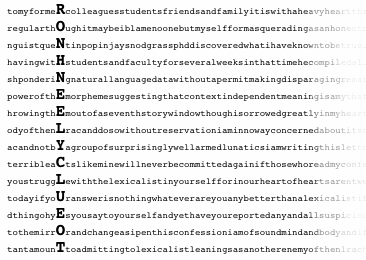Lewiston, Maine
Several of Professor Sampson’s students were alarmed when they read “An Official Confession”, dated July 19th. In this confession, Sampson admitted to being a lexicalist, and apologized for it. Though the confession appeared to be sincere, there were several inconsistencies that his students found in the confession that clued them into the truth.
The first thing his students noticed was that the confession was signed “Sartoris Ojars Sampson”. Sampson’s middle name is actually “Pjars”, but the change to “Ojars” (a common typo amongst his students) turns his initials into “S.O.S.” Additionally, the confession, which appeared in the August 2009 issue of SpecGram, was dated July 19, 3009.
 Analysis of Sampson’s coerced confession, aided by the clue hidden in the “error” in the date of the confession, revealed the clue that lead to his eventual liberation. |
“Yeah, Professor Sampson’s nuts about dates,” DeShwanne Lester, one of Sampson’s students, told SpecGram Wire Services. “He once threw a student out of class for wishing him a happy birthday at the beginning of class. It was his birthday, I guess, but since he was born at 5:37 p.m. and class started at 5:00 p.m., he kind of lost it; said that student was trying to insult him by saying it’s his birthday when it wasn’t. Yeah, so we knew something was up; he wouldn’t do that.”
A group of his students, working in conjunction with his colleagues, discovered the secret based on the date clue. Beginning with an offset of nine, if one takes every three hundredth letter of Sampson’s confession, it spells out: “Ron H. Neely. Clue: OT.”
Ron H. Neely, of course, is the second most popular name amongst male linguistics professors (and seventh most popular amongst female professors), but the clue “OT”, referring to “Optimality Theory”, helped SpecGram’s Special Operations Forces narrow the search down to the eighteen linguistics professors who are named “Ron H. Neely” and specialize in Optimality Theory. After thirteen misfires (including another Ron H. Neely who specializes in Optimality Theory at UNM), they hit the jackpot on their fourteenth try.
Professor Neely was immediately taken into custody, but committed suicide before police could interrogate him. An autopsy confirmed that Neely managed to swallow a cyanide capsule hidden in a fake molar shortly after his arrest. His last words were synonymous with the slogan of the Natural Language Research Approval Committee (NLRAC): “We shall triumph!”

Authorities are investigating the role the NLRAC may have played in the abduction of Professor Sampson. Shortly after news broke of Sampson’s rescue, the NLRAC’s leader, Professor Quentin Popinjay Snodgrass, released the following statement:
We at the NLRAC are deeply saddened by the recent events, about which we were recently made aware. Though the news is shocking, we find it more shocking that the late Professor Neely felt it necessary to implicate the NLRAC in this dastardly offense. It is an obvious lexicalist trick to defame and demonize our cause. Rest assured that we at the NLRAC will not be deterred by such acts, and shall press on: We shall triumph!
Numeric messages left on Prof. Snodgrass’s pager were not immediately returned.